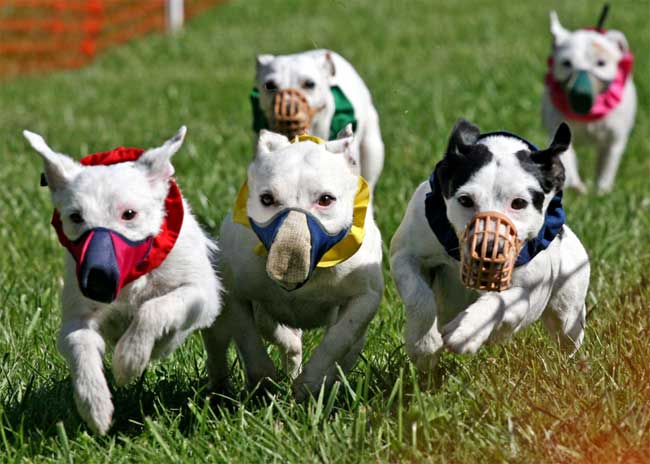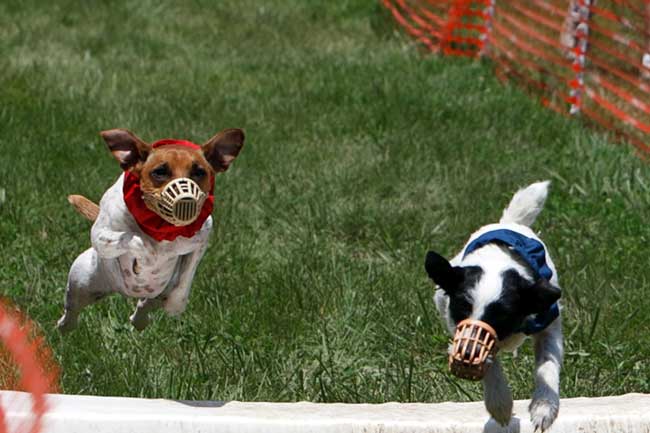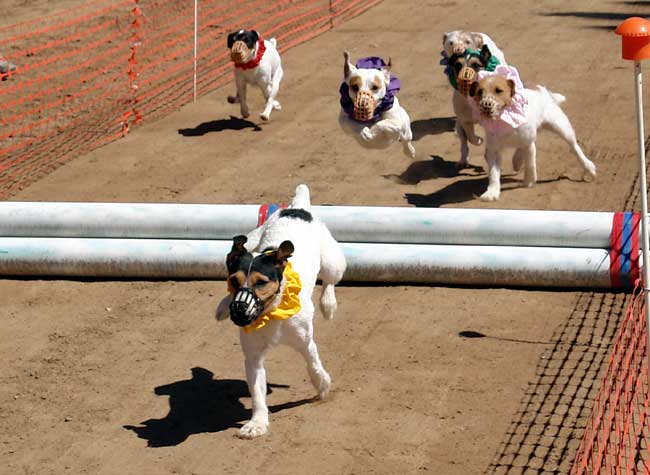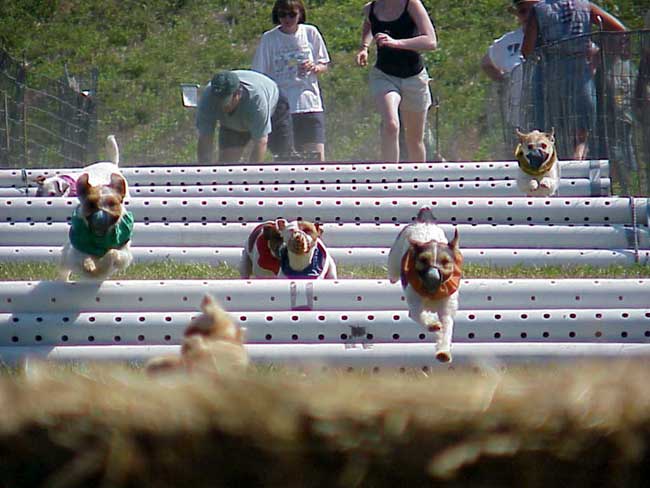Jack Russell Terrier Racing
Racing is perhaps the most exciting of all the terrier trial events. There are two types of races: flat and hurdles.

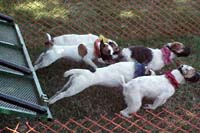 Racing is perhaps the most exciting of all the terrier trial events. There are two types of races: flat and hurdles (also known as Steeplechase). A JRTCA sanctioned track must be minimum of 150 feet long (200+ feet is recommended), and is a straight course with a starting box at one end and a stack of straw bales (foam is highly recommended) with a hole in the middle (the finish line) at the other. A lure (usually a piece of scented fur) is attached to a piece of string that is pulled along by a Lure machine. The dogs are muzzled for safety (theirs and the catchers). The first dog to cross the finish line (behind the bales at the entry to the catch pen) is the winner. That is not always the dog that was first as they entered the hole in the hay bales!
Racing is perhaps the most exciting of all the terrier trial events. There are two types of races: flat and hurdles (also known as Steeplechase). A JRTCA sanctioned track must be minimum of 150 feet long (200+ feet is recommended), and is a straight course with a starting box at one end and a stack of straw bales (foam is highly recommended) with a hole in the middle (the finish line) at the other. A lure (usually a piece of scented fur) is attached to a piece of string that is pulled along by a Lure machine. The dogs are muzzled for safety (theirs and the catchers). The first dog to cross the finish line (behind the bales at the entry to the catch pen) is the winner. That is not always the dog that was first as they entered the hole in the hay bales!
Each race may be a series of heats, semis, and finals. A championship race is run in each division and is a competition between the winners of the flat and hurdle races. To qualify for the championships those dogs MUST have run in BOTH their flat and hurdle races.
Racing Equipment
- Race Course - 150 foot (minimum) to 225 foot straight course with 15 foot (minimum) to 20 foot catch area; usually uses plastic fencing for sides; about 8-10 feet wide; best if designed to go slightly uphill.
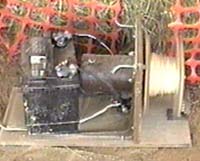 Starter Box - should be large enough to hold six adult Jack Russell Terriers, up to 15 inches in height; usually made of wood; uses either springs or hinges on the front; front made of strong wire (or clear plastic) to allow terriers to see the lure; the floor of the box should either be natural (i.e., grass, dirt) or be made of material (i.e., carpeting) that will allow the terrier to grip.
Starter Box - should be large enough to hold six adult Jack Russell Terriers, up to 15 inches in height; usually made of wood; uses either springs or hinges on the front; front made of strong wire (or clear plastic) to allow terriers to see the lure; the floor of the box should either be natural (i.e., grass, dirt) or be made of material (i.e., carpeting) that will allow the terrier to grip.- Lure Pull - motor connected to a car battery; can use pulley system to allow controller to stand near the middle of the track.
- Lure - a piece of fur, or cloth that is tied to several hundred feet of string. The Lure Pull drags it down the race track for the terriers to follow.
- Bales - marks the end of the course; used to construct a finish line which consists of a hole about the size of a large Jack Russell Terrier; also used to pad the back of the catching area (should not be reinforced with heavy materials for safety reasons - i.e., terrier may be injured if it collides with reinforced straw bale); the hole should be at least 8 inches wide. Please use bales that are not too heavy and tightly packed and can hurt the terriers (or use foam which is much safer). WHATEVER MATERIAL IS USED TO FORM HOLE AND BACKSTOP, IT SHOULD OFFER A CUSHION FOR TERRIER IMPACT AND BE WRAPPED IN SUCH A WAY TO MAKE A SMOOTH SURFACE THAT WILL NOT POKE EYES OR FEET.
- Muzzles - for dog and catcher safety; all sanctioned trials require that the terriers be muzzled using either a plastic or metal basket or a softie muzzle (no figure 8 or open ended muzzles are allowed).
- Hurdles - used in the hurdle or steeplechase races; minimum of 4 hurdles placed at least 20 feet apart. The last hurdle should not be closer than 30 feet from the finish line. Each hurdle should be made of lightweight material, should slant away from the terrier for safety reasons and be flush with the fencing; no taller than 8" for puppies and no taller than 16" for adults.
- Racing Collars - colored collars made of fabric worn around the terriers neck to determine the order of finish; colors should be easily distinguishable from each other to avoid confusion (i.e., a different color for each entry in a heat).
Racing Officials
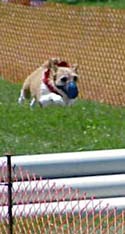 Racing Judge - stands at the finish line marking the order of finish; the judge's decision is final.
Racing Judge - stands at the finish line marking the order of finish; the judge's decision is final.- Racing Steward - organizes class entries into heats; assign color collars; check muzzles for proper type and fit; observe race for slipped muzzles or fighting terriers; assist in the selection process for starting box position.
- Racing Starter - makes sure dogs are properly loaded into the starting gate; opens the gate; signals lure operator to start the lure/race; help observe activity in front of the straw bales (i.e., fighting, catching lure).
- Dog Catchers - six able-bodied people (minimum of 14 years of age - 18 years old is recommended) to catch the dogs in the catch area; gloves recommended.
- Results Board Recorder - records race results from racing judge, posts heat board; assigns qualifiers to subsequent races (quarter-finals, semis, finals, championships).
- Lure Operator - operates the lure machine when signaled by the Racing Starter.
- Lure Handler - returns the lure to the starting gate after each heat (use multiple lure handlers to avoid tiring them out).
Racing Rules
For the most up-to-date rules on racing, please refer to the JRTCA Sanctioned Trial Rule Book.
Racing Classes
The Racing Division at a sanctioned trial consists of two sections: Flat and Steeplechase (Hurdle).
Flat Races- Pups (6-9 months, 10 to 12 1/2, splitting by sex is optional)
- Pups (6-9 months, over 12 1/2 to 15, splitting by sex is optional)
- Pups (9-12 months, 10 to 12 1/2, splitting by sex is optional)
- Pups (9-12 months, over 12 1/2 to 15, splitting by sex is optional)
- Dogs (1 year and older, 10 to 12 1/2)
- Dogs (1 year and older, over 12 1/2 to 15)
- Bitches (1 year and older, 10 to 12 1/2)
- Bitches (1 year and older, over 12 1/2 to 15)
- Veterans (6 years and older, 10 to 12 1/2)
- Veterans (6 years and older, over 12 1/2 to 15)
- Pups (6-9 months, 10 to 12 1/2, splitting by sex is optional)
- Pups (6-9 months, over 12 1/2 to 15, splitting by sex is optional)
- Pups (9-12 months, 10 to 12 1/2, splitting by sex is optional)
- Pups (9-12 months, over 12 1/2 to 15, splitting by sex is optional)
- Dogs (1 year and older, 10 to 12 1/2)
- Dogs (1 year and older, over 12 1/2 to 15)
- Bitches (1 year and older, 10 to 12 1/2)
- Bitches (1 year and older, over 12 1/2 to 15)
- Veterans (6 years and older, 10 to 12 1/2)
- Veterans (6 years and older, over 12 1/2 to 15)
- Puppy Championships (10 to 12 1/2)
- Puppy Championships (over 12 1/2 to 15)
- Adult Championships (10 to 12 1/2)
- Adult Championships (over 12 1/2 to 15)
- Veteran Championships (10 to 12 1/2)
- Veteran Championships (over 12 1/2 to 15)
How to Train Your Terrier to Race
 You can start race training of your terrier in your own back yard. The idea is to get them used to chasing a lure so that when they are in a real race, they will know what to do. You can use the following items to perform the training:
You can start race training of your terrier in your own back yard. The idea is to get them used to chasing a lure so that when they are in a real race, they will know what to do. You can use the following items to perform the training:
- String and Lure - Tie a piece of fur (a sock will work also) to a 20 foot piece of string
- Racing Muzzle - to get your terrier used to wearing one
- Tease the terrier with the fur (to get its attention)
- Run away from your terrier with the lure trailing behind you
- Let your terrier catch the fur so that it will be a satisfying experience for it. Repeat these steps several times.
- Hurdles - Build simple hurdles from inexpensive PVC piping. Drag the lure over the hurdle to get your terrier to jump. It works!
- The best practice for racing is to actually run your terrier in a real race (i.e., with other terriers, muzzles, spectators, etc). Attend a fun day for good practice.
- Start your terrier racing at a young age (4 months). Don't let them race over large hurdles since their joints are still growing!
- Don't let your terrier overheat.
Racing Tips
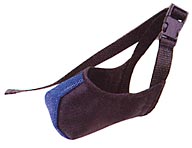
- Use a "softie" muzzle or a basket muzzle; mickey and figure-eight muzzles are illegal as the terriers are unable to breathe properly
- Practice makes perfect - rarely does a first time racing terrier do well. Normally they either sit in the starting box, play with their muzzle, or run the wrong direction. Don't quit after the first failure. Jack Russells are smart and catch on quickly.
- Remember that you are there to have fun - not to argue. Let's make sure racing doesn't get a bad name. It's an exciting event and tempers can flare. Remember to thank the catchers and the racing staff. They've got a tough job.
- Allow your terrier to watch some of the races to get excited. After awhile, you probably won't have to do this since your terrier will know when it's race time.
- If your terrier starts a fight, work to stop this behavior immediately. Fighting terriers are dismissed since they can disrupt the outcome of the race and are a danger to the other terriers and the catchers.
- If you think your terrier is close to moving up to the next height division (i.e., over 12 1/2 inches), get a JRTCA height card. It'll save you a lot of hassles at trials. To get a height card, you need to have two sanctioned American Conformation Judges measure your terrier.
- Cool down your terrier after each race (some owners will "dunk" their terriers in a large barrel of water after each race). You can use a mist spray bottle and offer your terrier plenty of water.
- Be sure to remove the terrier's leash and regular collar before you put it in the starting box.
- Have a friend or family member help you when you race your terrier (i.e., help with muzzle, pick up terrier after the race).
Racing Photos
